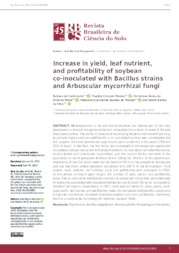Increase in yield, leaf nutrient, and profitability of soybean co-inoculated with Bacillus strains and Arbuscular mycorrhizal fungi.
Increase in yield, leaf nutrient, and profitability of soybean co-inoculated with Bacillus strains and Arbuscular mycorrhizal fungi.
Autoria: LEITE, R. da C.; PEREIRA, Y. C.; OLIVEIRA-PAIVA, C. A.; MORAES, A. J. G. de; SILVA, G. B. da
Resumo: Microorganisms in the soil and rhizosphere can release part of the total phosphorus in the soil through solubilization, mineralization, and an increase of the root absorption surface. The ability of phosphate solubilizing bacteria and mycorrhizal fungi to promote higher yield and profitability in co-inoculated soybean was investigated. For this purpose, field and greenhouse experiments were conducted in the years 2020 and 2021 in Brazil. In the field, the first factor was composed of microorganism application on soybean (simple inoculation with Bradyrhizobium; co-inoculation with Bacillus strains; co-inoculation with arbuscular mycorrhiza), and the second factor consisted of the application or not of phosphate fertilizer (0 and 100 kg ha-1 of P2O5). In the greenhouse, treatments of the first factor were maintained with 50 % of the phosphate fertilization and one treatment added (standard inoculation with 100 % of the fertilization). Plant growth, roots, nodules, leaf nutrition, yield, and profitability were evaluated. In 2020, co-inoculation increased plant height, the number of pods, grains, and profitability index. The co-inoculation with Bacillus strains and arbuscular mycorrhiza promoted yield increase only associated with phosphate fertilization, by 813 and 761 kg ha-1 compared to standard inoculation, respectively. In 2021, there were increases for pods, grains, yield, gross profit, net income, and profitability index. Co-inoculation with Bacillus strains and arbuscular mycorrhiza promoted increased soybean yield and profitability, confirming itself as a sustainable technology for Brazilian soybean fields.
Ano de publicação: 2022
Tipo de publicação: Artigo de periódico
Unidade: Embrapa Milho e Sorgo
Palavras-chave: Bacillus megaterium, Bacillus subtilis, Fungo, Inoculação, Micorriza, Rhizophagus intraradices, Soja
Observações
1 - Por padrão são exibidas publicações dos últimos 20 anos. Para encontrar publicações mais antigas, configure o filtro ano de publicação, colocando o ano a partir do qual você deseja encontrar publicações. O filtro está na coluna da esquerda na busca acima.
2 - Para ler algumas publicações da Embrapa (apenas as que estão em formato ePub), é necessário ter, no celular ou computador, um desses softwares gratuitos. Sistemas Android: Google Play Livros; IOS: iBooks; Windows e Linux: software Calibre.
Acesse outras publicações
Acesse a Base de Dados da Pesquisa Agropecuária (BDPA) para consultar o acervo completo das bibliotecas da Embrapa.

